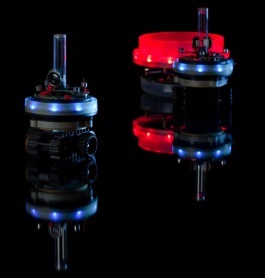In my PhD work [1], I used groups of foraging robots that could emit and perceive light to communicate, to explore how different evolutionary conditions can determine the level of reliability of evolving signals. In agreement with evolutionary theory, the reliability of the resulting communication system was found to depend on the level of relatedness between robots in a group and the level at which they were selected [2]. Robots that were highly related or selected at the group level evolved reliable signals, despite the competition [3]. In contrast, when relatedness between robots in a group was low and selection was acting at the level of the individual, robots were selected to suppress the inadvertent cues produced while foraging. However, because of the effect of mutations, these cues were never completely suppressed and some variability in signalling was maintained [4].
The PhD thesis resulted in three main contributions: Firstly, because similar co-evolutionary processes should be common in natural systems, the findings provide a possible explanation as to why communicative strategies are so variable in many animal species when interests between them conflict. Secondly, they predict that the level at which selection operates will play an important role in the evolution of signal reliability in natural systems of communication. Finally, the work illustrates how evolutionary robotic systems can be used to explore issues that cannot easily be studied experimentally with living organisms, such as the evolution of cooperative behaviour, and thus contribute to our understanding of biological systems [5].
Related publications
1. S. Mitri (2009) The Evolution of Communication in Robot Societies. PhD thesis, Lausanne.
2. S. Mitri, D. Floreano and L. Keller (2011) Relatedness Influences Signal Reliability in Evolving Robots. Proc Royal Soc B 278:378-383. [html] [pdf]
3. D. Floreano, S. Mitri, S. Magnenat and L. Keller (2007) Evolutionary Conditions for the Emergence of Communication in Robots. Current Biology 17:514-519. [html] [pdf]
4. S. Mitri, D. Floreano and L. Keller (2009) The Evolution of Information Suppression in Communicating Robots with Conflicting Interests. PNAS 106:15786-15790. [html] [pdf]
5. S. Mitri, S. Wischmann, D. Floreano and L. Keller (2012) Using Robots to Understand Social Behavior. Biological Reviews. [html]

